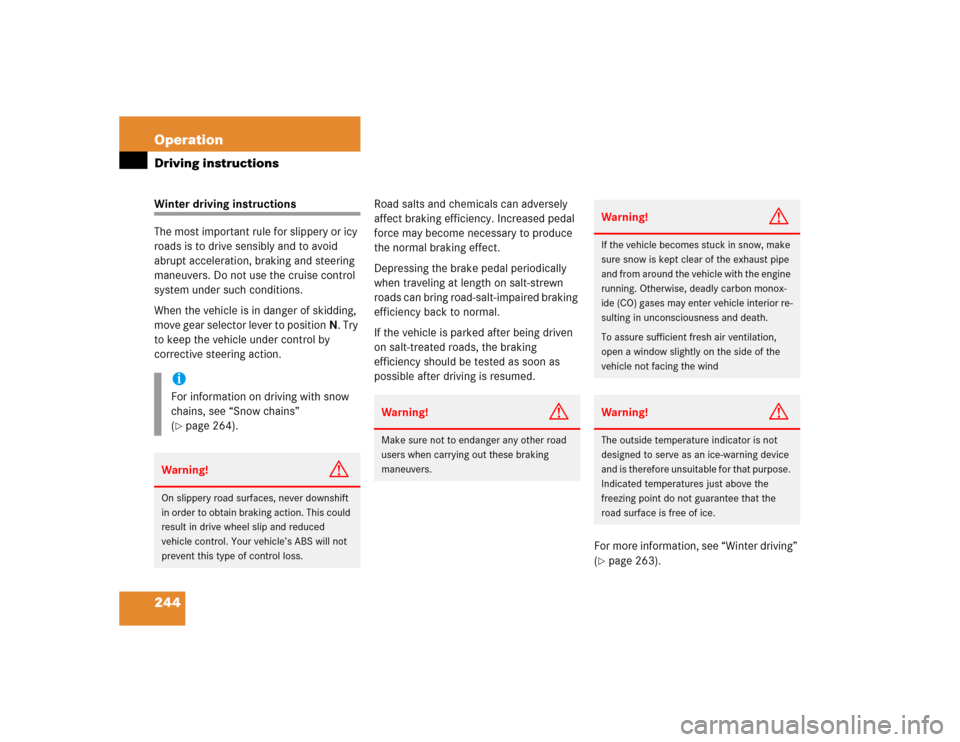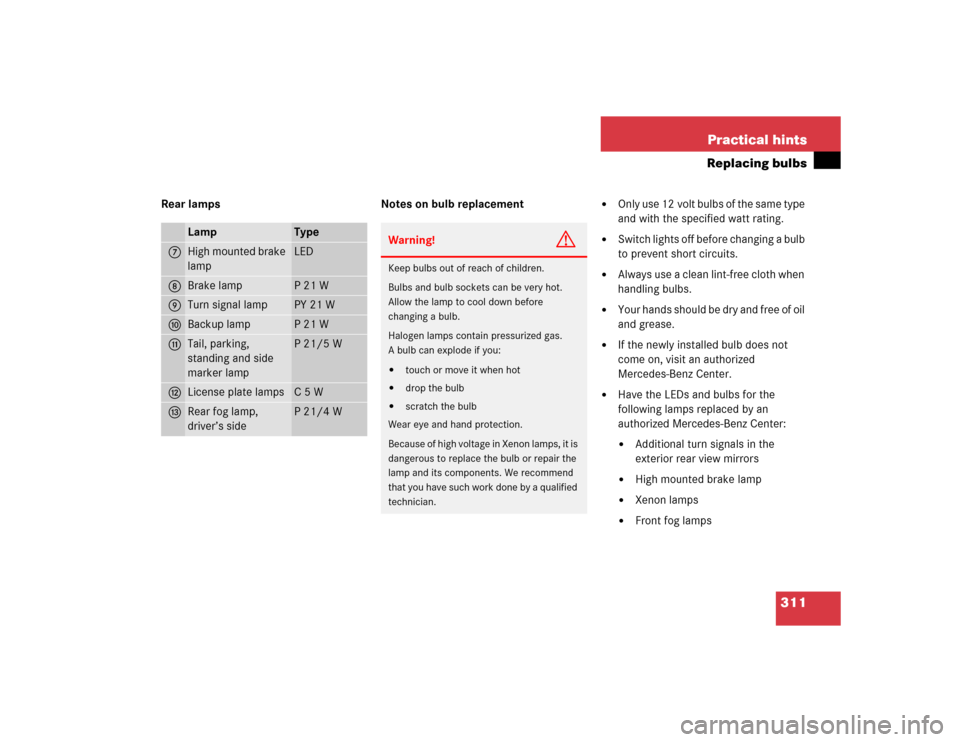Page 244 of 400

244 OperationDriving instructionsWinter driving instructions
The most important rule for slippery or icy
roads is to drive sensibly and to avoid
abrupt acceleration, braking and steering
maneuvers. Do not use the cruise control
system under such conditions.
When the vehicle is in danger of skidding,
move gear selector lever to positionN. Try
to keep the vehicle under control by
corrective steering action.Road salts and chemicals can adversely
affect braking efficiency. Increased pedal
force may become necessary to produce
the normal braking effect.
Depressing the brake pedal periodically
when traveling at length on salt-strewn
roads can bring road-salt-impaired braking
efficiency back to normal.
If the vehicle is parked after being driven
on salt-treated roads, the braking
efficiency should be tested as soon as
possible after driving is resumed.
For more information, see “Winter driving”
(
�page 263).
iFor information on driving with snow
chains, see “Snow chains”
(�page 264).
Warning!
G
On slippery road surfaces, never downshift
in order to obtain braking action. This could
result in drive wheel slip and reduced
vehicle control. Your vehicle’s ABS will not
prevent this type of control loss.
Warning!
G
Make sure not to endanger any other road
users when carrying out these braking
maneuvers.
Warning!
G
If the vehicle becomes stuck in snow, make
sure snow is kept clear of the exhaust pipe
and from around the vehicle with the engine
running. Otherwise, deadly carbon monox-
ide (CO) gases may enter vehicle interior re-
sulting in unconsciousness and death.
To assure sufficient fresh air ventilation,
open a window slightly on the side of the
vehicle not facing the windWarning!
G
The outside temperature indicator is not
designed to serve as an ice-warning device
and is therefore unsuitable for that purpose.
Indicated temperatures just above the
freezing point do not guarantee that the
road surface is free of ice.
Page 246 of 400

246 OperationDriving instructionsControl and operation of radio transmitter
COMAND*, radio and telephone*Telephones* and two-way radios
Radio transmitters, such as a portable
telephone or a citizens band unit should
only be used inside the vehicle if they are
connected to an antenna that is installed
on the outside of the vehicle.
Refer to the radio transmitter operation
instructions regarding use of an external
antenna.
Catalytic converter
Your Mercedes-Benz is equipped with
monolithic-type catalytic converters, an
important element in conjunction with the
oxygen sensors to achieve substantial
control of the pollutants in the exhaust
emissions. Keep your vehicle in proper
operating condition by following our
recommended maintenance instructions
as outlined in your Service Booklet.
Warning!
G
Please do not forget that your primary
responsibility is to drive the vehicle safely.
Only operate the COMAND (Cockpit
Management and Data System), radio or
telephone
1 if road, weather and traffic
conditions permit.
Bear in mind that at a speed of just 30 mph
(approximately 50 km/h), your vehicle is
covering a distance of approximately
44 feet (approximately 13.5 m) every
second.
1Observe all legal requirements.
Warning!
G
Never operate radio transmitters equipped
with a built-in or attached antenna (i.e. with-
out being connected to an external antenna)
from inside the vehicle while the engine is
running. Doing so could lead to a malfunc-
tion of the vehicle’s electronic system,
possibly resulting in an accident and/or
personal injury.
!To prevent damage to the catalytic
converters, only use premium unleaded
gasoline in this vehicle.
Any noticeable irregularities in engine
operation should be repaired promptly.
Otherwise, excessive unburned fuel
may reach the catalytic converter,
causing it to overheat and start a fire.
Page 311 of 400

311 Practical hints
Replacing bulbs
Rear lamps Notes on bulb replacement
�
Only use 12 volt bulbs of the same type
and with the specified watt rating.
�
Switch lights off before changing a bulb
to prevent short circuits.
�
Always use a clean lint-free cloth when
handling bulbs.
�
Your hands should be dry and free of oil
and grease.
�
If the newly installed bulb does not
come on, visit an authorized
Mercedes-Benz Center.
�
Have the LEDs and bulbs for the
following lamps replaced by an
authorized Mercedes-Benz Center:�
Additional turn signals in the
exterior rear view mirrors
�
High mounted brake lamp
�
Xenon lamps
�
Front fog lamps
Lamp
Type
7
High mounted brake
lamp
LED
8
Brake lamp
P21W
9
Turn signal lamp
PY 21 W
a
Backup lamp
P21W
b
Tail, parking,
standing and side
marker lamp
P21/5W
c
License plate lamps
C5W
d
Rear fog lamp,
driver’s side
P21/4W
Warning!
G
Keep bulbs out of reach of children.
Bulbs and bulb sockets can be very hot.
Allow the lamp to cool down before
changing a bulb.
Halogen lamps contain pressurized gas.
A bulb can explode if you:�
touch or move it when hot
�
drop the bulb
�
scratch the bulb
Wear eye and hand protection.
Because of high voltage in Xenon lamps, it is
dangerous to replace the bulb or repair the
lamp and its components. We recommend
that you have such work done by a qualified
technician.
Page 372 of 400

372 IndexF
Fahrenheit
Setting temperature units 125
Fastening the seat belts 40
Fine adjustment
Cruise control 204
First aid kit 300
Flat tire 318
Lowering the vehicle 322
Minispare wheel 302
Mounting the Minispare wheel 318
Preparing the vehicle 318
Flexible fuel vehicles 350
At the gas station 249
Switching fuels 350
Flexible Service System (FSS) 265
Flexible service system (FSS) 358
Fog lamp, rear 103, 311Fog lamps
Replacing bulbs 310
Fog lamps, front
Messages in display 294
Replacing bulbs 311
Switching on 102
Four wheel electronic
traction system (4MATIC) with ESP 79
4MATIC 79
Front airbags 61
Front lamps
Bi-Xenon type 313
Halogen-type 312
Messages in display 293–296
Replacing bulbs 310, 312
Front seat head restraints
Installing 91
Manual seat 91
Power seat* 92
Removing 91Front seats
Heater* 95
FSS 358
FSS (Flexible Service System) 265
Fuel 250
Additives 350
Cruising range 351
E85 (Ethanol fuel) 351
Fuel reserve warning lamp 278
Gasoline additives 350
Premium unleaded
gasoline 250, 347, 349
Requirements 349
Reserve warning 23
Switching (Flexible fuel vehicle) 350
Technical data 346
Fuel additives 350
Fuel consumption statistics
After start 135
Since last reset 135
Page 373 of 400

373 Index
Fuel filler flap 249
Locking 249
Opening 308
Unlocking 249
Fuel requirements 349
Fuel reserve tank
Message in display 293
Fuel tank
Capacity 347
Filler flap 249
Fuels, coolants, lubricants etc.
Capacities 346
Functions (control system) 112, 115
Resetting 122
Fuse box 333
Fuse chart 333
Fuse extractor 334
Fuses 333
Auxiliary fuse box in
cargo compartment 334
Fuse box in engine compartment 333Fuse box in
passenger compartment 333
Fuse chart 333
Fuse extractor 334
Spare fuses 334
G
Garage door opener 27, 230
Gasoline see Fuel
Gasoline additives
Gear range 358
Automatic transmission 141
Limiting 141
Shifting into optimal 140
Gear range limit
Canceling 140
Gear selector lever 23
Cleaning 271
Lock 43
Position 142
Position
(automatic transmission) 23, 139Global
Locking 85
Unlocking 85
Global positioning system (GPS) 358
Glove box 21, 215
Closing 215
Opening 215
Good visibility 145
GPS 358
GPS see COMAND*
H
Halogen-type
Front lamp bulbs 312
Hands-free microphone 27
Hard plastic trim items
Cleaning 271
Hazard warning flasher 104
Switching off 104
Switching on 104